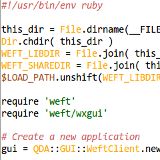Open Source, Competition and Developer Choice
Since around 2001 I’ve been using the Ruby programming language for everyday programming needs. Amongst other things, I used the WxRuby package to write desktop applications using Ruby, most notably the Weft QDA software for analysing qualitative data analysis. For several years from around 2006 I also led development of WxRuby.
These experiences of on-line collaboration in the production of free software got me interested in how voluntary software projects attract users and gain momentum. There is, of course, a large literature on open-source software development. A simple characterisation might go: in traditional, commercial software development, the ends and the tools for their achievement are centrally specified, and involvement in development is more or less closed; in open-source software development, various individuals, organisations and companies pursue their own goals, openly sharing their tools and techniques (code) and adopting those of others as they satisfy their own purposes.
The Ruby GUI Survey
The (late 2000s) state of Ruby tools for producting Graphic User Interfaces (GUIs) seemed an interesting case study in open-source development. There were, and still are, numerous tools which provide similar functions, all of them maintained by volunteer effort. The division of total effort across several packages seemed detrimental to the underlying aims of each. One question was thus: did the various users of the packages choose one or other tool out of a ‘rational’ choice: i.e. having considered a variety, one in particular provided particular features and characteristics that made it especially attractive? Or did historical and cultural features, and the difficulty, for users, in assessing packages, explain the long-standing division of technologies.
To research this I set up in 2008 an online survey for ruby users; the results are summarised here, with links to a full report. Also in Japanese.
